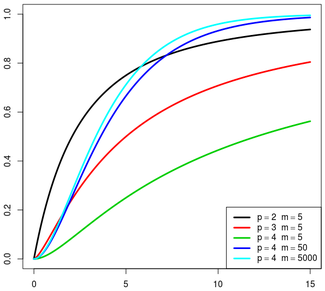Hotellingsche T-Quadrat-Verteilung
| Hotellingsche T-Quadrat-Verteilung | |
Dichtefunktion  | |
Verteilungsfunktion | |
| Parameter | p – Dimension der Zufallsvariablen m – verknüpft mit der Stichprobengröße |
|---|---|
| Träger | if otherwise. |
Die Hotellingsche T-Quadrat-Verteilung[1] ist eine Wahrscheinlichkeitsverteilung, die 1931 von Harold Hotelling erstmals beschrieben wurde.[2] Sie ist eine Verallgemeinerung der Studentschen t-Verteilung.
Definition
Die quadratische Form
folgt einer Hotellingschen T-Quadrat-Verteilung mit
- einer Anzahl von Punkten
- ist ein Spaltenvektor mit Elementen
- ist eine -Kovarianzmatrix
Eigenschaften
Es sei eine Zufallsvariable mit einer multivariaten Normalverteilung und (unabhängig von ) habe eine Wishart-Verteilung mit einer nicht-singulären Kovarianzmatrix und mit . Dann ist die Verteilung von : , Hotellingsche T-Quadrat-Verteilung mit Parametern und .
Für die F-Verteilung gilt:
- .
Unter der Annahme, dass
-Spaltenvektoren mit reellen Zahlen sind.
sei der Mittelwert. Die positiv definite -Matrix
sei ihre Stichproben-Kovarianzmatrix. (Die Transponierte einer Matrix sei mit bezeichnet). sei ein -Spaltenvektor (bei Anwendung ein Schätzer des Mittelwertes). Dann ist die Hotellingsche T-Quadrat-Verteilung
hat eine enge Beziehung zum quadrierten Mahalanobis-Abstand.
Wenn unabhängig sind und und wie oben definiert sind, dann hat eine Wishart-Verteilung mit Freiheitsgraden, so dass[3]
und ist unabhängig von und
- .
Daraus folgt
Einzelnachweise
- ↑ Hotelling's T². Glossary of statistical terms. In: International Statistical Institute. 1. Juni 2011, abgerufen am 25. September 2020 (englisch).
- ↑ H. Hotelling (1931). The generalization of Student’s ratio, Ann. Math. Statist., 2(3), S. 360–378, doi:10.1214/aoms/1177732979 JSTOR:2957535.
- ↑ K.V. Mardia, J.T. Kent, and J.M. Bibby (1979) Multivariate Analysis, Academic Press, ISBN 0-12-471250-9.
Auf dieser Seite verwendete Medien
Autor/Urheber: Matheus H J Saldanha, Lizenz: CC BY-SA 4.0
Hotelling distribution probability density function
Autor/Urheber: Matheus H J Saldanha, Lizenz: CC BY-SA 4.0
Hotelling distribution cumulative distribution function

